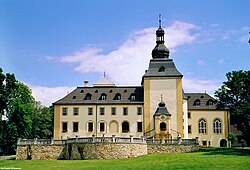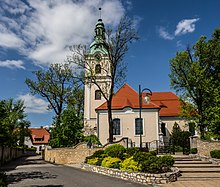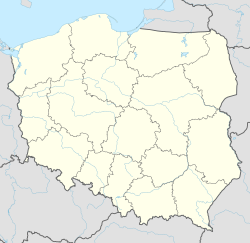Kamień Śląski
Kamień Śląski | |
|---|---|
Village | |
 Palace | |
| Coordinates: 50°33′N 18°5′E / 50.550°N 18.083°E | |
| Country | |
| Voivodeship | Opole |
| County | Krapkowice |
| Gmina | Gogolin |
| First mentioned | 12th century |
| Population | 1,500 |
| Time zone | UTC+1 (CET) |
| • Summer (DST) | UTC+2 (CEST) |
| Vehicle registration | OKR |
| Website | http://www.kamienslaski.pl |
Kamień Śląski (Polish pronunciation: [ˈkamjɛj̃ ˈɕlɔ̃skʲi]) is a village in the administrative district of Gmina Gogolin, within Krapkowice County, Opole Voivodeship, in south-western Poland.[1] It lies approximately 9 kilometres (6 mi) north-east of Gogolin, 13 km (8 mi) north-east of Krapkowice, and 17 km (11 mi) south-east of the regional capital Opole.
The main landmarks of are the local Kamień Śląski palace, which houses a sanctuary dedicated to Saint Hyacinth of Poland, who was born in the village, and the Saint Hyacinth church.
History
[edit]
The oldest known mention of the village comes from the early-12th-century Gesta principum Polonorum, the oldest Polish chronicle.[2] It was mentioned as a seat of Polish ruler Bolesław III Wrymouth, both under the Latinized Polish name Kamencz and under the translated Latin name Lapis.[2] The name is of Polish origin and means "stone". It was part of Piast-ruled Poland, and was owned by the Odrowąż family.[2] Later on, it was also part of Bohemia, Prussia and Germany.
After the restoration of independent Poland after World War I in 1918, the local Polish majority made efforts to reintegrate the village with Poland. In the local elections in 1919, Poles won 11 out of 12 seats.[3] During the Second Silesian Uprising, the village was easily captured by the Poles.[3] Despite the Upper Silesia plebiscite of 1921, in which 55,3% voted in favour of rejoining Poland, the village was assigned to Germany, and soon afterwards it was the place of bloody fights during the Third Silesian Uprising.[3] A German unit committed a crime and murdered five Polish civilians.[3] In May 1921 the village passed between the fighting sides several times, before it was eventually seized by the Germans, while Polish insurgents retained control of the local railway station.[3] Fights ended on May 31, 1921, when French troops entered the village and established a neutral zone.[3] In the final stages of World War II, in January 1945, Soviet troops entered the village and plundered the St. Hyacinth chapel, and afterwards the village was restored to Poland.[2]
In 2012, the St. Hyacinth church in Kamień Śląski received church bells from the closed and demolished former Polish and Redemptorist monastery in Bochum, Germany.[4][5][6]
Notable residents
[edit]- Ceslaus Odrowąż (ca. 1180–ca. 1242), Polish Dominican priest, Blessed of the Catholic Church[2]
- Hyacinth of Poland (ca. 1183–1257), Polish Dominican priest and missionary, founder of the first Dominican monastery in Poland (in Kraków), Saint of the Catholic Church[2]
- Bronislava of Poland (c. 1203–1259), Polish nun of the Premonstratensian Order, Blessed of the Catholic Church[2]
- Hyazinth Graf Strachwitz (1893–1968), general
References
[edit]- ^ "Central Statistical Office (GUS) - TERYT (National Register of Territorial Land Apportionment Journal)" (in Polish). 2008-06-01.
- ^ a b c d e f g "Kamień Śląski historia miejscowości". GWO24.pl (in Polish). Retrieved 22 May 2021.
- ^ a b c d e f "Kamień Śląski". Opolski Szlak Powstań (in Polish). Retrieved 22 May 2021.
- ^ "Dzwony z Bochum biją w Kamieniu Śląskim". Nowa Trybuna Opolska (in Polish). Retrieved 22 May 2021.
- ^ "Polnische Seelsorger im Ruhrgebiet" (in German). Retrieved 22 May 2021.
- ^ Sabine Vogt. "Der Kirchturm fällt nächste Woche". Der Westen (in German). Retrieved 22 May 2021.


